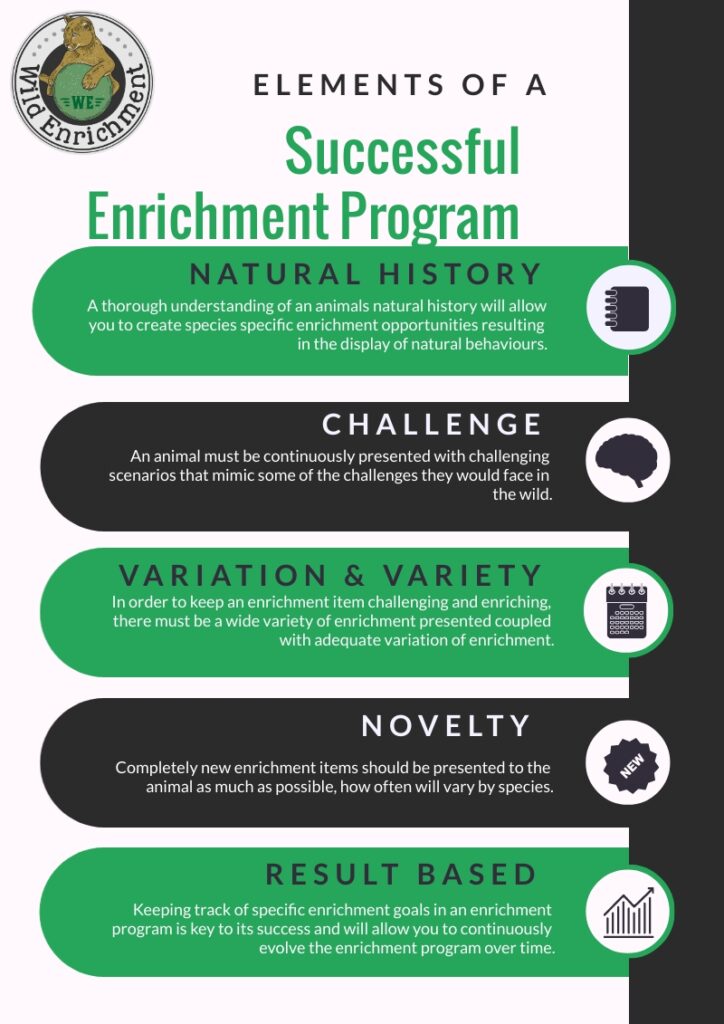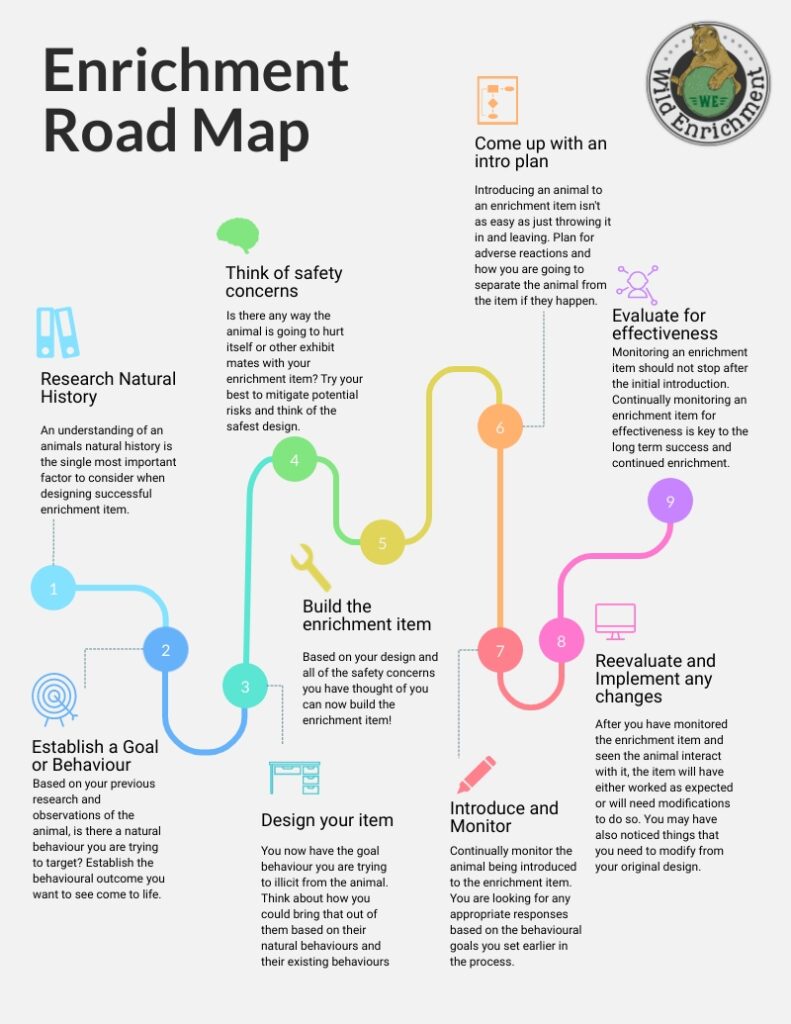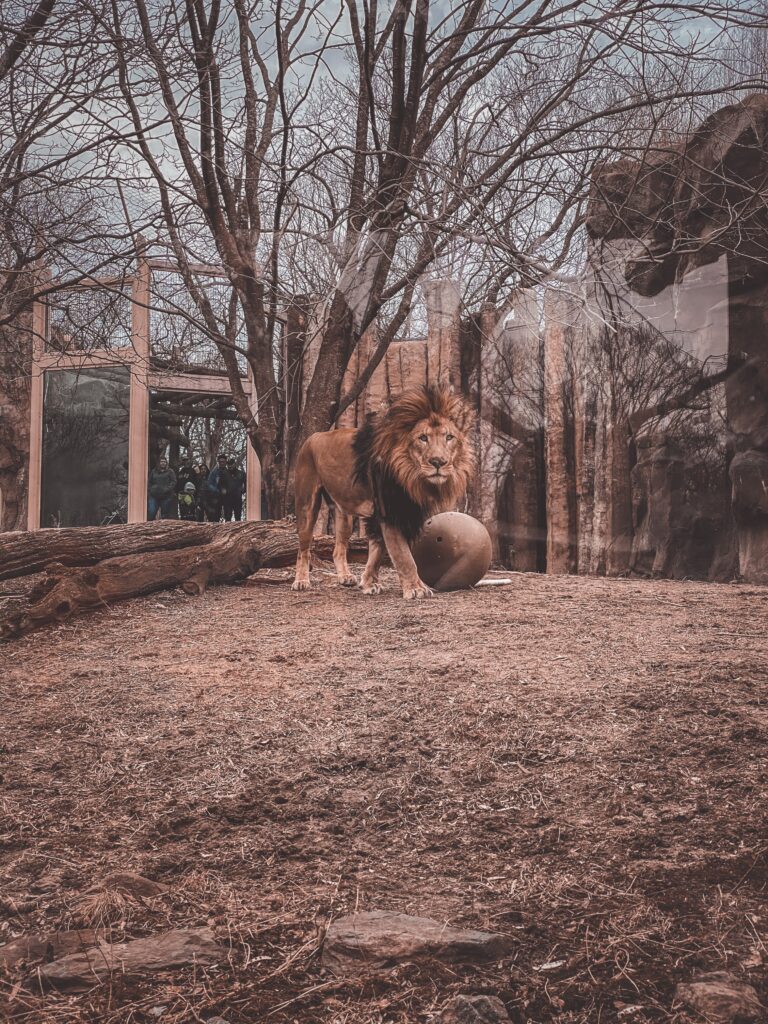Enrichment for captive animals comes in many forms, from scent based enrichment, social enrichment and environmental enrichment. In many animal care institutions across the world enrichment is still considered to be an “extra” and not part of the normal day to day husbandry routine. Im writing this article to give a definitive argument as to why enrichment should be considered essential for almost every single animal in captivity, and should be treated as such.
First of all, we aren’t attacking anyone with this article.
I wanted to start this article by saying that I am not writing it in order to try to attack people or institutions that do not do enrichment. There are many reasons that an animal care professional might not do enrichment, from anecdotal reasons, such as an animals adverse reaction to an enrichment item, a lack of time in the day or a lack of education on the subject. It’s very easy for these bad habits and anecdotes to get passed down in the work force, one keeper that does not do enrichment may have taught another keeper that an animal does not react to enrichment or that it is dangerous for them.
It is important to remember that almost all animal care professionals got into this industry for the same reasons, we love animals and want to do the absolute best we can to care for them. It’s because of this fact that the information presented in this article should not be used to assume that someone is refusing to do enrichment because they don’t care about animal welfare. Instead, the information provided in this article should be used to begin an evidence based and compassionate approach to implementing an enrichment program or helping to bolster an existing one.
Captivity lacks complexity
As we have talked about many times before in previous articles, captivity is inherently lacking many of the challenges and stimulus that a wild animal would encounter in its day to day life. Inherently, the captive environment is a fixed one, whereas an animal in the wild would be experiencing an infinitely variable one. Enrichment as a whole, seeks to increase the variability and challenge in a captive animals environment. When an animal is presented with an environment that does not meet the appetite for cognitive stimulation millions of years of evolution has bestowed upon their brains, it begins to adversely effect their welfare. We have known about the benefits of enrichment for quite some time, as well as its effect on overall animal welfare that it has.
The documented benefits of enrichment for zoo animals range from changes in behaviour, such as decreasing aggression, increasing activity and decreasing abnormal behaviour, to improved reproduction and health and increased survival of captive-bred animals released into the wild.
The Biology of Animal Stress: Basic Principals for Animal Welfare, Pg. 377, Gary P. Moberg, Joy A. Mench, 2000
The introduction of novel stimuli and response possibilities enhanced space usage while reducing activities typically attributed to boredom.
Yanofsky, R., Markowitz, H. Changes in General Behavior of Two Mandrills (Papio Sphinx) Concomitant with Behavioral Testing in the Zoo. Psychol Rec 28, 369–373 (1978)
The effects of three environmental conditions—bare exhibit, manipulables present, and manipulables plus edibles present—on the gross motor activity of four captive orangutans were compared using a multielement design. Results indicated that activity increased under the enriched conditions with increases in activity type specific to the environmental change.
Increasing activity in captive orangutans: Provision of manipulable and edible materials. Zoo Biology 4. 225-234. (1984)
In complex environments developing animals learn that performing active behavior produces appropriate functional outcomes. Learning to control their environment influences their ability to adapt to novel situations, which may profoundly influence their reproductive behavior as adults in breeding situations. Chronic stress may compromise reproductive physiology and behavior; enrichment reduces stress by providing increased opportunity for behavioral coping responses.
Kathy Carlstead. David Shepherdson. Effects of environmental enrichment on reproduction. Zoo Biology 13:5. 447-458. (1994)
It is clear based on the studies presented above that enrichment was already being heavily researched and its benefits on animal welfare were understood over 20 years ago. In order to fully grasp how detrimental an environment void of complexity can be to an animal in captivity, I think it is important to talk about animal welfare and some of the signs of compromised welfare.

Signs of compromised welfare
One of the most important thing to clearly define when thinking about animal welfare is the difference between animal welfare and animal rights. Animal rights is a philosophical understanding that animals have similar fundamental rights that would be granted to a human; this is not what we are talking about in this article. In this article we are talking strictly about animal welfare, which is defined as an animals ability to cope with the environment in which it lives.
When you boil down animal welfare into its fundamental parts, it is whether or not an animal is negatively stressed due to its environment/ surroundings or not. I specify “negative stress” here due to the fact that animals in the wild are generally coping with many different stressors such as hunger, thirst, and environmental stressors, so saying that all stressors are bad for animal welfare would probably be misguided.
Although the actual criteria for assessing animal welfare is not as cut and dry as we would like to believe, there are many signs that an animal care professional can look out for that would point to the animal being under too much stress. Many of these behaviours are categorized as stereotypic behaviours which are behaviours that are highly repetitive and serve no purpose. One of the most obvious stereotypic behaviours is pacing and head bobbing. There are also more severe stereotypies such as feather plucking and over grooming which can be very destructive to an animals welfare.
The appearance of these behaviours is almost always a sign that the animal has made an attempt to adapt to the environment it is in and has failed. These behaviours are really coping behaviours because the animal is extremely stressed in its environment and is unable to adequately perform species specific natural behaviours. Just because an animal is not displaying stereotypic behaviours does not mean that it is free from stress and thus has adequate welfare; there are many other signs that an animal is having trouble coping with the stress of its environment. Poor social interaction, compromised reproductive and immune function, and even developmental issues are all signs of poor welfare and high stress levels. Preventing these behaviours from occurring and stopping them from continuing is where enrichment comes in.
The potential benefits of enrichment on animal welfare
As we have talked about in many different posts, enrichment means a lot of different things to different species. Enrichment should be created and administered to an animal based on their natural behaviours and should always be goal based. If the enrichment is not goal based and based off of an animals natural history in any way it is likely not appropriate for that animal. There are exceptions to this, sometimes there will be an animal that is very enriched by a piece of enrichment that is not based on any of the criteria previously discussed. This is why, it is also important to have variety in an animals enrichment program and also important to try different enrichment with an animal although it may not be enriching on paper (as long as the enrichment is still safe for that animal), however, this enrichment needs to be monitored and scrutinized heavily before being adapted into regular day to day rotation. So in this section we will be talking about the benefits appropriate enrichment can have on a variety of animals.
Firstly, one of the most pronounced effects that environmental enrichment can have on an animal is a reduction or cessation of self destructive behaviours and stereotypic behaviours. As we have previously discussed, these behaviours can in some cases, be thought of as having a direct link to compromised welfare. However, based on the research out there on this subject, it is important to note that enrichment has the largest effect on these negative behaviours when they first start to occur, as long term negative behaviours can become resistant to change and may be impossible to break. Environmental enrichment has the potential to affect these negative behaviours by allowing the animal to adapt to its captive environment through allowing them to express natural behaviours and face challenges similar to what their wild counterparts may face on a day to day basis.
Not only does environmental enrichment have the potential to reduce or stop negative behaviours brought on by stress, but it also has many other potential mental benefits as well. In rats, enrichment was actually shown to induce an optimistic cognitive bias when compared to their counterparts that live in a barren environment. Basically this means that enrichment was able to change the “mental lens” through which, the rat viewed its surroundings, giving it a more positive outlook on all the stimulus it was presented with. Another fascinating aspect of this study was that, when the rats housed in a barren environment, were switched to an enriched environment, their cognitive bias changed with the move from pessimistic or negative too optimistic. This study further reinforces the fact that enrichment has a profound affect on the way an animal is interpreting its environment.
Living in an enriched environment may also play a significant role in the effectiveness a training program may have on an animal. In a study conducted on pigs, researchers found that pigs housed in an enriched environment learned new behaviours and solved a maze puzzle significantly quicker than their counterparts housed in a barren environment. Not only do animals learn more rapidly in an enriched environment, but they also are more willing to participate in training and enrichment sessions than individuals without access to enrichment.
It appears that by affecting the metal state of an animal, enrichment in turn affects the physical state of an animal as well. There are several studies outlining how environmental enrichment can increase activity levels of many animals, from pigs to orang-utans. One of the main ways enrichment can cause an animal to be significantly more active is the fact that food based enrichment can significantly increase foraging time (amount of time an animal spends looking for food) and it can make the animals environment as a whole significantly more interactive and challenging.
It is clear based on the above paragraphs, that environmental enrichment can not only prevent, reduce or completely stop negative behaviours, benefit animals mentally through changing their cognitive bias, help speed the learning process and even significantly increase activity levels in a variety of species. Now that we have established these potential benefits of enrichment, we can now talk about a few strategies to start to implement an enrichment program for an animal.

Strategies to start an enrichment program
Getting started on an enrichment program can be tough and very demoralizing, especially when you are working with other people that may or may not “believe” in enrichment. It is time to stop the rhetoric around not “believing” in the benefits of enrichment, the science has been around for decades and the entire scientific community has voted that yes, enrichment is good for animal welfare. At most animal care institutions, job descriptions will include “must provide appropriate care” or “deliver day to day husbandry” for the animals they are responsible for. Based on the current science, it’s clear that “appropriate care” and “animal husbandry” are inclusive of enrichment. People that do not understand this, have a massive potential to fail to deliver appropriate care standards to the animals they are caring for.
When it comes to animal husbandry, the most detrimental and potentially harmful thing someone can say is:
We have tried that before. This is the way we have always done it.
Someone scared of change.
In my experience, the resistance to beginning to implement enrichment into the day to day husbandry of an animal comes from two place in most people, the first being ego. Sometimes, depending on how you frame your approach to implementing an enrichment program, by wanting to change the husbandry routine of an animal, you are insinuating that the way the animal was being cared for prior to enrichment was incorrect and wrong (although this might be true), and this may offend people and cause resistance. The second place resistance comes from is well intentioned worry. People worry that providing animals with enrichment, may cause them harm and result in injury or even death, and while inappropriate enrichment definitely has the potential to do so, there are strategies to offer appropriate enrichment safely in order to minimize risk.
The fact is most people in the animal care business are in it for the right reasons and want to provide the best care possible for the animals they look after. Therefore when approaching your coworkers with a proposed enrichment program, make sure you are doing it from a non accusatory standpoint and focus on the potential benefits the new plan would have instead of the downfalls the old plan currently has.
Starting an enrichment program
Check out our other articles and our resources page for more help designing an enrichment program, or contact us and we would be more than happy to assist you in designing and implementing an enrichment program at your facility!


Safety Considerations
Before implementing any new enrichment program or enrichment device, make sure a thorough introduction and review plan is followed to ensure the safety of the animal it is being presented too. If you want to read more about this, check out this article.
Conclusion
In conclusion, it is clear based on the above paragraphs, that environmental enrichment can not only prevent, reduce or completely stop negative behaviours, benefit animals mentally through changing their cognitive bias, help speed the learning process and even significantly increase activity levels in a variety of species. Implementing an enrichment program is not always easy and can be met with resistance, these roadblocks must be met with compassion and understanding that generally the resistance is not coming from a place of spite, but often a place of pride, worry and deep sense of caring for the animal in question.
Good luck! And remember, enrichment isn’t an extra!
Resources
Here is a list of all the articles that I used for this article that may help you read up on some of the benefits enrichment can have on an animal. If you want more resources, check out our resources page.
- The Effect of Environmental Enrichment on Learning in Pigs
- The effects of four types of enrichment on feather-pecking behaviour in laying hens housed in barren environments
- Environmental enrichment for ostrich, Struthio camelus, chicks
- Effects of Environmental Enrichment on Behaviour and Productivity of Growing Pigs
- Environmental enrichment: Increasing the biological relevance of captive environments
- Sensory stimulation as environmental enrichment for captive animals: A review
- Computer-assisted enrichment for zoo-housed orangutans (Pongo pygmaeus)
- The potential of the human–animal relationship as an environmental enrichment for the welfare of zoo-housed animals
- A Critical Review of Zoo-based Olfactory Enrichment
- Training is enrichment—And beyond
- Environmental enrichment induces optimistic cognitive bias in rats
- Increasing activity in captive orangutans: Provision of manipulable and edible materials
- The Choice to Access Outdoor Areas Affects the Behavior of Great Apes
- Why and how should we use environmental enrichment to tackle stereotypic behaviour?
- Middle-aged mice with enrichment-resistant stereotypic behaviour show reduced motivation for enrichment

